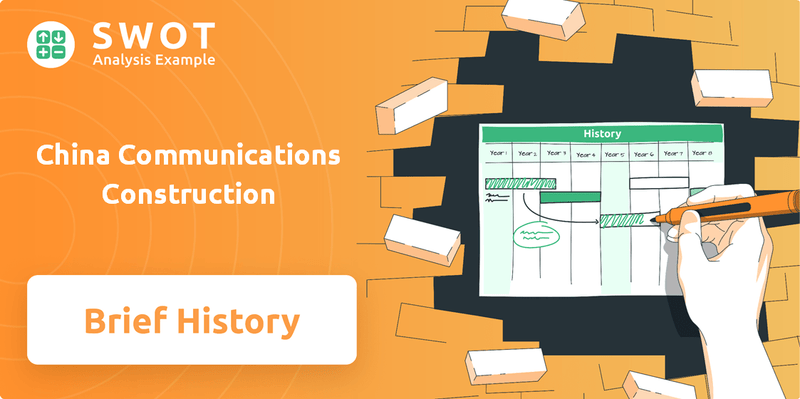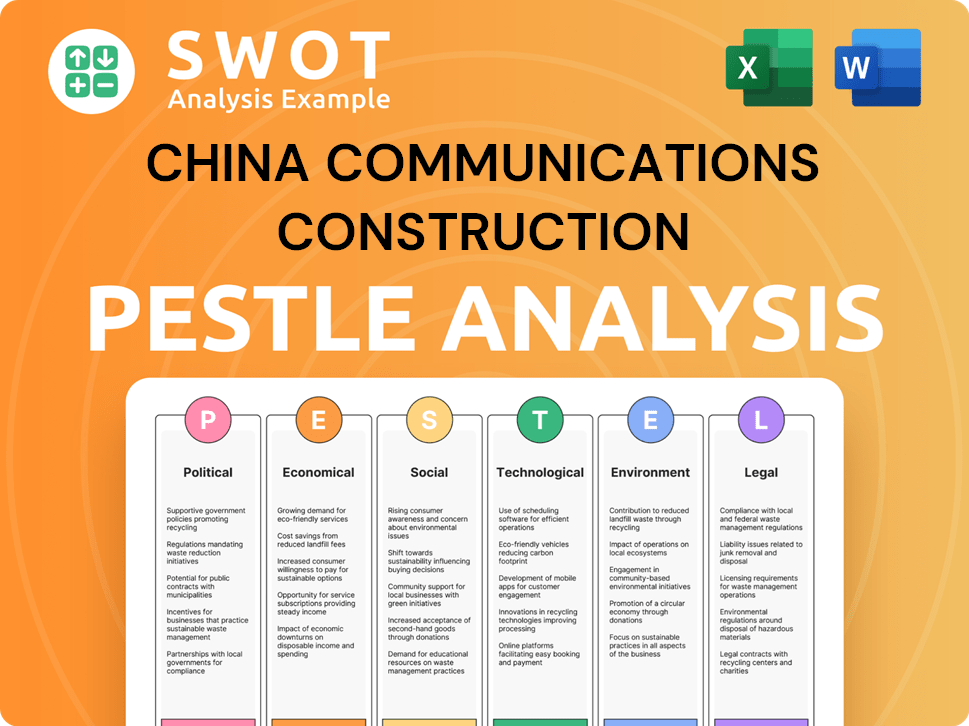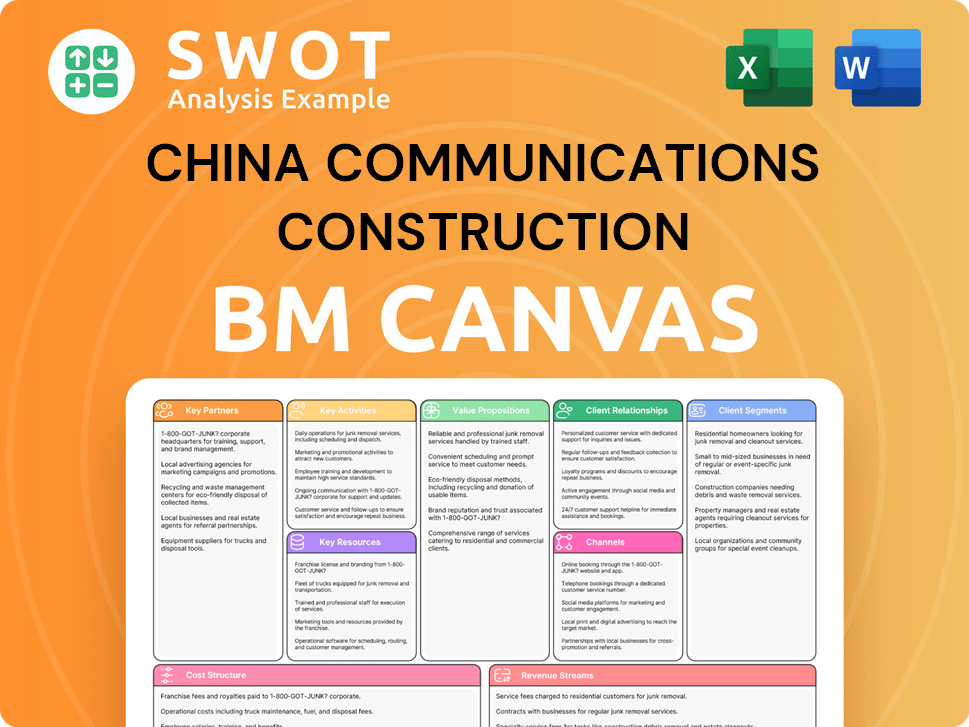China Communications Construction Bundle
How did a Chinese construction giant rise to global prominence?
Delve into the China Communications Construction SWOT Analysis to understand the strategic landscape. From its humble beginnings in the early 20th century to its current status as a global infrastructure leader, the China Communications Construction Company (CCCC) has a fascinating story. Discover the brief history CCCC and the pivotal moments that shaped this Chinese construction company.

The CCCC history is a testament to China's rapid infrastructure development China and its ambition on the global stage. Understanding What year was CCCC founded and the subsequent mergers offers critical context. Explore the CCCC company profile to uncover how this enterprise has navigated challenges and capitalized on opportunities to become a world-class player.
What is the China Communications Construction Founding Story?
The story of China Communications Construction Company (CCCC) began with a strategic vision to consolidate China's infrastructure prowess. This led to the formal incorporation of CCCC on October 8, 2006. This move aimed to create a global leader in integrated infrastructure services.
The formation of CCCC was a result of merging two major players in the Chinese construction industry. The parent company, China Communications Construction Group (CCCG), was established on December 18, 2005, through the merger of China Harbour Engineering (Group) Company and China Road and Bridge Corporation. These predecessors had a rich history, with China Road and Bridge Engineering Co. Ltd. being one of the first Chinese companies to venture into international engineering in 1979.
The company quickly aimed for global expansion, as seen by its initial public offering (IPO) on the Hong Kong Stock Exchange on December 15, 2006. This early entry into the international capital market highlighted CCCC's ambition and strategic importance in global markets. The initial business model focused on providing integrated solutions for infrastructure projects, from investment to operation, covering areas like ports, roads, and railways.
CCCC's founding was a strategic move to create a global leader in infrastructure.
- 2005: CCCG formed through the merger of China Harbour Engineering and China Road and Bridge Corporation.
- October 8, 2006: CCCC formally incorporated.
- December 15, 2006: CCCC listed on the Hong Kong Stock Exchange.
- The company focused on integrated solutions for infrastructure projects.
CCCC's early focus was on large-scale infrastructure projects both domestically and internationally. The company's initial offerings included port and terminal construction, road and bridge projects, and railway and tunnel construction. It also manufactured heavy machinery, such as container cranes and dredgers. This comprehensive approach allowed CCCC to manage projects from start to finish, providing a one-stop solution for clients. The company's rapid growth and expansion have been a key part of its story.
The company's early strategic decisions set the stage for its future growth. CCCC's involvement in projects such as port construction and its role in the Belt and Road Initiative have further solidified its position in the global market. For more details, you can explore the Target Market of China Communications Construction.
China Communications Construction SWOT Analysis
- Complete SWOT Breakdown
- Fully Customizable
- Editable in Excel & Word
- Professional Formatting
- Investor-Ready Format

What Drove the Early Growth of China Communications Construction?
The early years of China Communications Construction Company (CCCC), following its formation, were marked by rapid expansion and strategic growth. Incorporated in October 2006 and listed on the Hong Kong Stock Exchange in December 2006, CCCC quickly established itself as a major player in the infrastructure sector. A significant step in its development was the listing on the Shanghai Stock Exchange in March 2012, which strengthened its financial position and market presence.
CCCC was formally established in October 2006. Its initial public offering (IPO) on the Hong Kong Stock Exchange occurred in December 2006, followed by a listing on the Shanghai Stock Exchange on March 9, 2012. These listings provided crucial capital for its expansion and infrastructure development projects. The dual listing strategy enhanced its visibility and access to diverse investor bases.
The company broadened its service offerings beyond traditional construction. CCCC expanded into design, dredging, and heavy machinery manufacturing to provide comprehensive infrastructure solutions. This diversification enabled CCCC to undertake larger, more complex projects and capture a greater share of the infrastructure market. This approach enhanced its competitive advantage.
CCCC undertook significant international projects, including the Second Penang Bridge in Malaysia, completed in March 2014. The first phase of the Addis Ababa-Adama Highway in Ethiopia was completed in May 2015. The Zemun-Borca Bridge in Serbia, opened in December 2014, marked a significant milestone as the first bridge built by a Chinese company in Europe. These projects demonstrated CCCC's growing global presence.
Strategic acquisitions were crucial to CCCC's growth strategy. In August 2013, it acquired F&G, a leading offshore drilling unit design service provider. The acquisition of John Holland in Australia in May 2015 further expanded its expertise and global reach. These acquisitions helped CCCC to diversify its capabilities and enter new markets, contributing to its long-term growth and market position.
China Communications Construction PESTLE Analysis
- Covers All 6 PESTLE Categories
- No Research Needed – Save Hours of Work
- Built by Experts, Trusted by Consultants
- Instant Download, Ready to Use
- 100% Editable, Fully Customizable

What are the key Milestones in China Communications Construction history?
The China Communications Construction Company (CCCC) has a rich history marked by significant milestones in the infrastructure sector. It has played a crucial role in infrastructure development in China and globally, expanding its reach and impact over the years. The company's growth has been shaped by strategic projects and partnerships, solidifying its position as a leading Chinese construction company.
| Year | Milestone |
|---|---|
| 2006 | China Communications Construction Group was established through the merger of China Road and Bridge Corporation and China Harbour Engineering Group. |
| 2006 | CCCC was listed on the Hong Kong Stock Exchange. |
| 2010s | CCCC expanded its international presence, undertaking significant infrastructure projects worldwide, including in Africa and Asia. |
| Ongoing | CCCC continues to be a key player in the Belt and Road Initiative, contributing to global infrastructure development. |
Innovation is a core focus for CCCC, driving its technological advancements. The company has consistently invested in research and development, leading to numerous breakthroughs in the construction industry. This commitment to innovation has enhanced its competitiveness and project efficiency.
CCCC has achieved a remarkable record of 43 National Science and Technology Advancement Awards, 5 Technological Invention Awards, and 126 Zhan Tianyou Awards.
The company has secured 2 Chinese Golden Patent Awards and 39 Chinese Outstanding Patent Awards, holding a total of 37,175 authorized patents.
In March 2025, CCCC launched 'BlueWing-LLM,' an AI model specifically designed for the civil engineering sector, built on CCCC's extensive industry data.
The 'BlueWing-LLM' includes a 14-billion-parameter language model and a 7-billion-parameter multimodal model, already applied in over 30 scenarios.
This marks a significant step in CCCC's digital transformation and its commitment to intelligent construction.
Despite its successes, CCCC has faced several challenges throughout its history. These challenges include navigating complex regulatory environments and managing large-scale international projects. The company continues to adapt and improve its strategies to overcome these obstacles.
CCCC faces challenges inherent in large-scale international operations, including navigating diverse regulatory environments and geopolitical complexities.
Managing vast projects that require significant capital and resources presents ongoing challenges for the company.
Reports in 2025 have highlighted challenges related to labor and public safety in some overseas projects.
CCCC has demonstrated resilience, striving to overcome obstacles through continuous improvement and strategic adjustments.
The company's overseas operation networks now span over 140 countries and regions.
The company's ongoing commitment to 'stable profitability with continuous optimization of five ratios' reflects its strategy to address financial and operational challenges.
For a deeper understanding of the competitive landscape, consider exploring the Competitors Landscape of China Communications Construction.
China Communications Construction Business Model Canvas
- Complete 9-Block Business Model Canvas
- Effortlessly Communicate Your Business Strategy
- Investor-Ready BMC Format
- 100% Editable and Customizable
- Clear and Structured Layout

What is the Timeline of Key Events for China Communications Construction?
The CCCC history is marked by significant milestones that have shaped its global presence. The Brief history CCCC includes the establishment of the Junpu Engineering Bureau in 1905, a precursor to the modern entity. Later, China Road and Bridge Engineering Co. Ltd. was founded in 1979, marking an early step in the company's global expansion, followed by the establishment of China Harbor Engineering Co. Ltd. in 1980. In 2005, the China Communications Construction Group (CCCG) was formed through a merger, and on October 8, 2006, China Communications Construction Company Limited (CCCC) was officially incorporated. The company listed its H shares on the Hong Kong Stock Exchange in December 2006 and its A shares on the Shanghai Stock Exchange in March 2012. Acquisitions, such as F&G in August 2013 and John Holland in May 2015, expanded its capabilities. The opening of the Mombasa-Nairobi Railway in May 2017, built by CCCG, showcased its infrastructure expertise. In March 2025, CCCC launched 'BlueWing-LLM,' an AI model for the civil engineering sector, and reported a trailing 12-month revenue of approximately $104 billion USD as of March 31, 2025.
| Year | Key Event |
|---|---|
| 1905 | Establishment of the Junpu Engineering Bureau, a predecessor to CCCC. |
| 1979 | China Road and Bridge Engineering Co. Ltd. founded, one of the first Chinese enterprises to 'go global'. |
| 1980 | China Harbor Engineering Co. Ltd. established. |
| 2005 | China Communications Construction Group (CCCG) formed through the merger of China Harbour Engineering (Group) Company and China Road and Bridge Corporation. |
| October 8, 2006 | China Communications Construction Company Limited (CCCC) incorporated. |
| December 15, 2006 | CCCC's H shares listed on the Hong Kong Stock Exchange. |
| March 9, 2012 | CCCC's A shares listed on the Shanghai Stock Exchange. |
| August 2013 | Acquired F&G, a world-leading offshore drilling unit design service and equipment provider. |
| May 2015 | Completed acquisition of John Holland company in Australia. |
| May 2017 | Kenya's Mombasa-Nairobi Railway, contracted and built by CCCG, opened for operation. |
| March 2025 | Launched 'BlueWing-LLM,' an AI model for the civil engineering sector. |
| March 31, 2025 | Reported a trailing 12-month revenue of $104 billion USD. |
CCCC aims to become a world-class enterprise by 2025. The company is focused on achieving a global industrial chain and governance system by around 2035. This includes increasing its transnational index to over 50% and transitioning from a first-class multinational to a first-class global company.
The company's strategy includes aligning with national development strategies and contributing to the Belt and Road Initiative. CCCC is also concentrating on the digitalization, intelligence, and green transformation of its traditional industries. It aims to enhance its 'Five Major Values' and achieve 'Stable Profitability with Continuous Optimization of Five Ratios' in 2025.
CCCC continues to expand its global presence. In June 2024, plans were announced to establish a project company in Botswana. The company is also involved in partnerships to promote Chinese-style modernization.
The East Coast Rail Link project in Malaysia, with CCCC as the contractor, is progressing towards its testing and commissioning phase in June 2026. As of April 2025, the project's overall progress was at 82.45%. These efforts align with CCCC's vision of building a closer world and improving lives.
China Communications Construction Porter's Five Forces Analysis
- Covers All 5 Competitive Forces in Detail
- Structured for Consultants, Students, and Founders
- 100% Editable in Microsoft Word & Excel
- Instant Digital Download – Use Immediately
- Compatible with Mac & PC – Fully Unlocked

Related Blogs
- What is Competitive Landscape of China Communications Construction Company?
- What is Growth Strategy and Future Prospects of China Communications Construction Company?
- How Does China Communications Construction Company Work?
- What is Sales and Marketing Strategy of China Communications Construction Company?
- What is Brief History of China Communications Construction Company?
- Who Owns China Communications Construction Company?
- What is Customer Demographics and Target Market of China Communications Construction Company?
Disclaimer
All information, articles, and product details provided on this website are for general informational and educational purposes only. We do not claim any ownership over, nor do we intend to infringe upon, any trademarks, copyrights, logos, brand names, or other intellectual property mentioned or depicted on this site. Such intellectual property remains the property of its respective owners, and any references here are made solely for identification or informational purposes, without implying any affiliation, endorsement, or partnership.
We make no representations or warranties, express or implied, regarding the accuracy, completeness, or suitability of any content or products presented. Nothing on this website should be construed as legal, tax, investment, financial, medical, or other professional advice. In addition, no part of this site—including articles or product references—constitutes a solicitation, recommendation, endorsement, advertisement, or offer to buy or sell any securities, franchises, or other financial instruments, particularly in jurisdictions where such activity would be unlawful.
All content is of a general nature and may not address the specific circumstances of any individual or entity. It is not a substitute for professional advice or services. Any actions you take based on the information provided here are strictly at your own risk. You accept full responsibility for any decisions or outcomes arising from your use of this website and agree to release us from any liability in connection with your use of, or reliance upon, the content or products found herein.